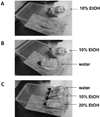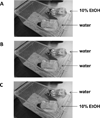The development of acamprosate as a treatment against alcohol relapse
- PMID: 25258174
- PMCID: PMC4578640
- DOI: 10.1517/17460441.2014.960840
The development of acamprosate as a treatment against alcohol relapse
Abstract
Introduction: Globally, alcohol abuse and dependence are significant contributors to chronic disease and injury and are responsible for nearly 4% of all deaths annually. Acamprosate (Campral), one of only three pharmacological treatments approved for the treatment of alcohol dependence, has shown mixed efficacy in clinical trials in maintaining abstinence of detoxified alcoholics since studies began in the 1980s. Yielding inconsistent results, these studies have prompted skepticism.
Areas covered: Herein, the authors review the preclinical studies which have assessed the efficacy of acamprosate in various animal models of alcohol dependence and discuss the disparate findings from the major clinical trials. Moreover, the authors discuss the major limitations of these preclinical and clinical studies and offer explanations for the often-contradictory findings. The article also looks at the importance of the calcium moiety that accompanies the salt form of acamprosate and its relevance to its activity.
Expert opinion: The recent discovery that large doses of calcium largely duplicate the effects of acamprosate in animal models has introduced a serious challenge to the widely held functional association between this drug and the glutamate neurotransmission system. Future research on acamprosate or newer pharmacotherapeutics should consider assessing plasma and/or brain levels of calcium as a correlate or mediating factor in anti-relapse efficacy. Further, preclinical research on acamprosate has thus far lacked animal models of chemical dependence on alcohol, and the testing of rodents with histories of alcohol intoxication and withdrawal is suggested.
Keywords: acamprosate; alcoholism; calcium; craving; glutamate; relapse.
Figures





Similar articles
-
Acamprosate. A review of its pharmacology and clinical potential in the management of alcohol dependence after detoxification.Drugs. 1997 Jun;53(6):1038-53. doi: 10.2165/00003495-199753060-00008. Drugs. 1997. PMID: 9179530 Review.
-
Acamprosate produces its anti-relapse effects via calcium.Neuropsychopharmacology. 2014 Mar;39(4):783-91. doi: 10.1038/npp.2013.264. Epub 2013 Sep 30. Neuropsychopharmacology. 2014. PMID: 24081303 Free PMC article.
-
Acamprosate: a review of its use in the maintenance of abstinence in patients with alcohol dependence.CNS Drugs. 2005;19(5):445-64. doi: 10.2165/00023210-200519050-00006. CNS Drugs. 2005. PMID: 15907154 Review.
-
Acamprosate for the adjunctive treatment of alcohol dependence.Ann Pharmacother. 2003 Jul-Aug;37(7-8):1090-9. doi: 10.1345/aph.1C351. Ann Pharmacother. 2003. PMID: 12841823 Review.
-
The clinical pharmacology of acamprosate.Br J Clin Pharmacol. 2014 Feb;77(2):315-23. doi: 10.1111/bcp.12070. Br J Clin Pharmacol. 2014. PMID: 23278595 Free PMC article. Review.
Cited by
-
Drugs to Treat Alcohol Dependence-A Perspective.J Addict Depend. 2016;2(2):10.15436/2471-061X-16-021. doi: 10.15436/2471-061X-16-021. Epub 2016 Jun 6. J Addict Depend. 2016. PMID: 29756083 Free PMC article.
-
How Imaging Glutamate, γ-Aminobutyric Acid, and Dopamine Can Inform the Clinical Treatment of Alcohol Dependence and Withdrawal.Alcohol Clin Exp Res. 2015 Dec;39(12):2268-82. doi: 10.1111/acer.12893. Epub 2015 Oct 28. Alcohol Clin Exp Res. 2015. PMID: 26510169 Free PMC article. Review.
-
Low dose baclofen and standard dose acamprosate had comparable changes in brain glutamate, brain Gamma amino butyric acid (GABA) and craving among patients with alcohol dependence syndrome: A 1H-MRS based open label randomized study.Ind Psychiatry J. 2025 Jan-Apr;34(1):25-31. doi: 10.4103/ipj.ipj_187_23. Epub 2025 Apr 18. Ind Psychiatry J. 2025. PMID: 40376631 Free PMC article.
-
Naltrexone Reverses Ethanol Preference and Protein Kinase C Activation in Drosophila melanogaster.Front Physiol. 2018 Mar 14;9:175. doi: 10.3389/fphys.2018.00175. eCollection 2018. Front Physiol. 2018. PMID: 29593550 Free PMC article.
-
Review of acamprosate pharmacokinetics and dosing strategies.Ment Health Clin. 2025 Apr 4;15(2):56-61. doi: 10.9740/mhc.2025.04.056. eCollection 2025 Apr 1. Ment Health Clin. 2025. PMID: 40224514 Free PMC article.
References
-
- World Health Organization. Global status report on alcohol and health. Switzerland: Geneva; 2014.
-
- O'Connor PG, Gottlieb LD, Kraus ML, et al. Social and clinical features as predictors of outcome in outpatient alcohol withdrawal. J Gen Int Med. 1991;6:312–316. - PubMed
-
- Ludwig AM, Wikler A, Stark LH. The first drink: psychobiological aspects of craving. Arch Gen Psychiatry. 1974;30:539–547. - PubMed
-
- McCusker CG, Brown K. Alcohol-predictive cues enhance tolerance to and precipitate "craving" for alcohol in social drinkers. J Stud Alcohol. 1990;51:494–499. - PubMed
Publication types
MeSH terms
Substances
Grants and funding
LinkOut - more resources
Full Text Sources
Other Literature Sources
Medical
